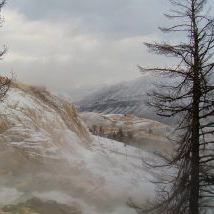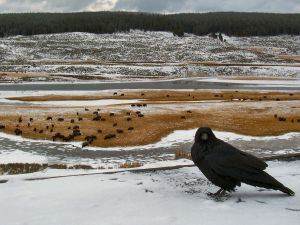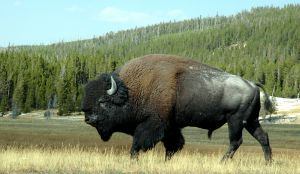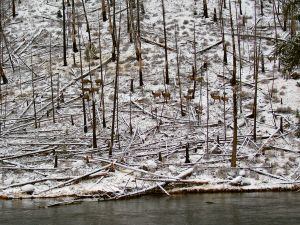Travel Tips
The Virtuous Traveler: Yellowstone National Park – Hot(ter)and Bothered
 While the winter weather was cold beyond compare, Leslie Garrett, The Virtuous Traveler, learned that climate change is warming up Yellowstone National Park in dramatic and devastating ways.
While the winter weather was cold beyond compare, Leslie Garrett, The Virtuous Traveler, learned that climate change is warming up Yellowstone National Park in dramatic and devastating ways.
I’m wearing enough woolly, wicking and water-repellent gear to outfit a polar expedition.
What’s more, I’m Canadian—I’m supposed to be built for this kind of weather.
And yet, I can barely feel my toes and I’m afraid my face has frozen into a grimace.
It’s mid-winter in Yellowstone National Park and I’m outside in negative 47-degree (with the wind chill) weather looking for wolves. I wonder, briefly, if I’ve lost my mind.
While the idea of looking for wolves is quite exciting, the reality of it proves an exercise in patience. While we’re waiting for a glimpse of the reclusive animals—seeking out clues such as elk huddled together which indicates they perceive a threat, or photographers huddled together which indicates they perceive a photo op—our guides offer up some information about the affects of climate change on Yellowstone.
I find myself longing for a little global warming—just a degree or two, would be nice.
Stop it! I scold myself. Climate change is bad.
 Louise Willcox, senior wildlife advocate for the Montana office of the Natural Resources Defense Council (NRDC), would agree. “You don’t have to go to the Arctic to see the effects of climate change,” she says, “It’s right in America’s oldest park.”
Louise Willcox, senior wildlife advocate for the Montana office of the Natural Resources Defense Council (NRDC), would agree. “You don’t have to go to the Arctic to see the effects of climate change,” she says, “It’s right in America’s oldest park.”
Even though I’m all too aware that our planet’s peril doesn’t play favorites, it’s hard to imagine Yellowstone as vulnerable to climate change. Yellowstone is so rugged. It’s vast, covering close to 3,500 square miles and joining Montana, Wyoming and Idaho. And in January, it’s so damn cold.
Even with a thick blanket of white as far as the eye can see, perhaps even because of that, the park is magnificent.
Find more travel articles about National Parks:
In many ways, Yellowstone stands as a truly American success story. Declared in 1872 by Ulysses S. Grant to be the world’s first national park, its status as “protected” seemed to ensure its future … and that of the wildlife and plant life that make it home. And Yellowstone has much on its resume to point to its survival.
 Bison, which once numbered in the millions in the U.S., all but disappeared in the late 1800s except for a handful of the great shaggy beasts that lived near Yellowstone. Included in Yellowstone’s “protected” status, they thrived and today there are roughly 3,000 bison roaming the park.
Bison, which once numbered in the millions in the U.S., all but disappeared in the late 1800s except for a handful of the great shaggy beasts that lived near Yellowstone. Included in Yellowstone’s “protected” status, they thrived and today there are roughly 3,000 bison roaming the park.
We marvel at the giants swinging their spectacular heads to sweep away snow and reveal the grass that makes up their diet. Or standing stock-still in the midst of a blizzard, seemingly impervious to the cold.
Be a more virtuous traveler yourself with our Eco-Travel section.
Yet Yellowstone is more vulnerable to the effects of climate change, we are told. Like any ecosystem, it’s a fragile web of interdependent checks and balances. A change in any—no matter how small—can set off a domino effect that leads to the eventual collapse of the whole thing.
And it just might happen sooner than later, says Willcox. She points to the park’s whitebark pine trees, some of which are more than one thousand years old. They’ve survived much, but are now being brought down by a small beetle, a native of the park. Those beetles can temporarily survive the park’s cold winter temperatures by producing an antifreeze-like substance, but 10 progressive days of below 40-degree temperatures will kill them off, ensuring that their numbers don’t get out of control and keeping them at lower elevations.
Traditionally, that allows the trees, which thrive above 8,500 feet, to flourish. Climate change, however, has meant there are fewer winters that offer those 10-day stretches of cold. Without the die-off, the beetles are increasing in numbers and attacking the trees with gusto.
“The speed of the beetle outbreak is breathtaking,” says Willcox. “When scientists first started seeing these patches of dead trees, it wasn’t clear the scale of the epidemic.”
She says scientists first predicted that Yellowstone would experience a slow die-off in a quarter-century. “But the whole place was clobbered in eight years.”
 But weep not just for the trees, but for all who rely on them: the park’s grizzlies that devour the tree’s high-calorie nuts to fatten up in the fall; the elk who rely on the trees for cover; birds, squirrels and chipmunks; spruce and pine saplings that need the larger trees for protection while they gain a foothold.
But weep not just for the trees, but for all who rely on them: the park’s grizzlies that devour the tree’s high-calorie nuts to fatten up in the fall; the elk who rely on the trees for cover; birds, squirrels and chipmunks; spruce and pine saplings that need the larger trees for protection while they gain a foothold.
“They’re a foundational species,” explains Willcox. “What you don’t see is the whole ecosystem surrounding the whitebark.”
Beth Pratt, environmental manager for Xanterra Parks and Resorts, a private operator contracted by the U.S. government to manage concessions at Yellowstone, Grand Canyon and other units of the National Park System, is another who is stunned by the decimation of the whitebark pine. She also points to a decline in three of four amphibian populations in the park. And, one of her favorites, the American Pika, a tiny mammal that looks like a cross between a rabbit and a mouse, is suffering declining numbers thanks to its predilection to overheating.
“They’re being pushed further and further up the range,” explains Pratt. “If temperatures continue to increase, even the highest elevations may no longer provide a home for the pikas and the species may be threatened to the point of extinction.” Pratt is presenting a course this summer through the Yellowstone Association that takes a look at the effects of climate change on Yellowstone.
What’s more, geologists confirm that the park’s lauded thermal features—and biggest tourist draw—including Old Faithful, will absolutely be affected by drought and reduced groundwater from decreased spring runoff.
Why not stay in a National Park itself? Check out The “Grand Dame” Hotels of the National Park System.
And another constant threat to Yellowstone, exacerbated by increasingly drier and hotter weather, is fire. It’s easy to still see the destruction from the wildfires of 1988, the largest combined fire in the park’s history and one that destroyed more than a third of the park.
Still, Pratt is heartened by the steps Yellowstone is taking to curb climate change. She admits that the previous presidential administration somewhat muzzled the parks in terms of giving out climate change information, but says that Xanterra is incorporating climate change information into visitor brochures in order to make the connection that the actions visitors take at home will impact these places and animals they love.
 Visitors to Yellowstone will also find a variety of “sustainable” menu options, from fish to vegetarian to organic offerings—close to a third of which is local.
Visitors to Yellowstone will also find a variety of “sustainable” menu options, from fish to vegetarian to organic offerings—close to a third of which is local.
But much of the greening of Yellowstone goes on behind the scenes, from an ambitious waste diversion program that’s cut landfill-bound garbage by 72 percent to an innovative plan that uses the leftover fuel from propane canisters to provide energy to a crusher. The crusher then crushes the canisters for recycling. Fifteen thousand of these have been kept out of landfill. Snowmobiles have largely been replaced with less-polluting four-stroke engines and vehicles are replaced by those with the highest Corporate Average Fuel Economy standards.
On a broader scale, environmentalists are also hopeful that state-wide policies will have an impact, but are battling over which ones will be the most effective. According to Mark Lambrecht, Regulatory Affairs Manager of electricity generator PPL (Pennsylvania Power and Light) Montana, the state is currently discussing a number of bills dealing with climate change. One major topic on the table is “carbon sequestration,” a process that would capture, compress and store CO2 underground.
Looking to get out and get active? Check out America the Beautiful: Hike America’s Trails or visit our Hiking & Biking section.
Meanwhile, Ken Toole of Montana Public Service Commission, who has debated Lambrecht on climate-changing solutions before the National Parks Conservation Association, questions the expense and effectiveness of carbon sequestration in this coal-mining state. Instead, he points to solutions such as solar, wind and geothermal power to positively impact climate change in the west.
Pratt remains, mostly, optimistic. “The fearful side of me wonders what’s going to be gone in 50 years,” she says, “but I’m hopeful that we can turn the tide.”
Willcox insists that the main goal of everyone is to “turn down the [global] thermostat … the rest is triage.”
A report released by the Natural Resources Defense Council entitled “Hotter and Drier” drew from 50 scientific studies and 125 other government and scientific sources confirms that the American West is heating up more than the world as a whole. And it’s the snow—serenely beautiful but my current nemesis—that is largely affected. Less snow, earlier melt and more winter rain is wreaking havoc on West, which relies on snow for 70 percent of its water.
The Natural Resources Defense Council cites climate change as such “a sweeping threat to the scenery natural and cultural resources and wildlife … that it dwarfs all previous risks” to Yellowstone.
We finally spot three wolves, thanks to a photographer who has made it his mission to photograph the Yellowstone packs and knows them by name. There are three of them—black, gray and white—lounging on rock ledges and posing as if for postcards. They look impossibly proud and defiant. Just like the park in which they make their home.
By Leslie Garrett for PeterGreenberg.com. Read more of Leslie’s articles here.
- For more information on climate change and Yellowstone National Park visit:
www.greeningyellowstone.org - For more information on travel in Yellowstone, check out:
www.yellowstonenationalpark.com - Visit Xanterra’s Web site at https://www.travelyellowstone.com
- Check out the Yellowstone Association Institute’s summer field courses and seminars here: www.yellowstoneassociation.org/institute
- For more information on the National Parks Conservation Association’s climate-change lecture series, visit www.npca.org/yellowstone_lecture_series
Related articles on PeterGreenberg.com:
- Yellowstone Hit By Swarm of Earthquakes
- Dude, Where’s My Horse?: Dude Ranch Vacations
- America the Beautiful: Five Hidden National Parks
- America the Beautiful: Five More Hidden National Parks
- The “Grand Dame” Hotels of Our National Parks
- Yellowstone National Park: Hot(ter) and Bothered
- Off the Brochure Travel Guide: Yosemite National Park
- Travel Video: Great Lesser-Known National Parks
- Tip: National Park Passes
- America the Beautiful: Hike America’s Trails












